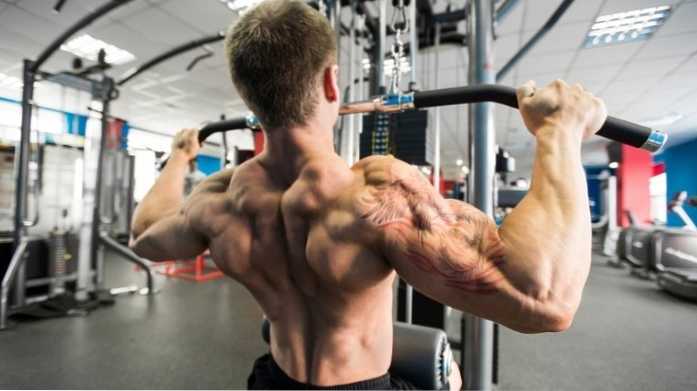
The 7 Best Back Exercises for Strength and Muscle Gain

Without a big, strong back, you won't get too far in your lifting and/or athletic endeavors. The back muscles help you to twist your torso, pull your arms in and down from overhead, and, most importantly, stabilize your spine. When you train these essential muscles, you'll be more efficient at pulling and twisting motions in general. Also, a bigger and stronger back will help you deadlift and bench press more weight more efficiently.
Here, you'll learn more about why back training is important and how to implement it into your routine. Also, we've curated the seven best back exercises for you to work into your routine.
Best Back Exercises
- Deadlift
- Pull-Up
- Bent-Over Row
- Chest Supported Row
- Single-Arm Dumbbell Row
- Inverted Row
- Lat Pulldown
Deadlift
The deadlift is one of the best compound exercises you can do to add serious amounts of strength and muscle mass to the back (as well as the hips and hamstrings). The deadlift has the ability to stress the back using moderate to heavy loads and can often be trained in higher volumes and loads, ultimately offering a one-of-a-kind training stimulus.
Benefits of the Deadlift
- It activates your back, but also your hamstrings, glutes, and the muscles in your hips.
- You can load up the deadlift with a lot of weight (once you're strong enough) to elicit major strength gains.
- You can also build more muscle since the deadlift can be done for lots of volume.
How to Do the Deadlift
Stand in front of a loaded barbell with your feet shoulder-width apart, hips back, and back flat. The knees should be bent slightly to allow you to grip the bar tightly slightly wider than shoulder-width. Keeping your back flat and chest up, tighten the back muscles, and straighten the arms as you load the pull. With everything locked, aggressively push your legs into the floor as you simultaneously pull your chest and shoulders upwards, lifting the bar to the hip.
Pull-Up
Don't think the pull-up is less effective than the other moves on this list because it's a bodyweight exercise. Pulling your body weight creates a level of instability that recruits your core muscles (to stabilize your body). Also, if you're on the heavier side (say, over 180 pounds), then you're still pulling a lot of weight. Lastly, it's always nice when you need limited equipment to do an exercise. In this case, you only need to own a pull-up bar to get this done.
Benefits of the Pull-Up
- You only need a pull-up bar to do this move, which you can buy for your home gym or find at a park.
- Stabilizing your own body weight will also recruit the muscles in your core.
- Your muscles will still respond to the relatively heavy load that is your own body.
How to Do the Pull-Up
Assume an overhead grip on the bar, slightly wider than shoulder-width. With the shoulder blades squeeze together, contract the core and upper back as you initiate the pull-up. Aim to pull your chin to or above the bar level.
Bent-Over Row
The bent-over row offers a lot of exercise variability. If you have access to kettlebells and dumbbells, you can row those or stick with the more traditional barbell variation. By hinging at your hips to row the weight to your stomach, you can really isolate the main muscles in your back - the lats, traps, and rhomboids. Like the deadlift, you can also load this movement up with more weight on other back movements. As a result, you're able to stimulate your muscles for greater strength gains and growth.
Benefits of the Bent-Over Row
- You can effectively perform the bent-over row with various tools such as kettlebells, dumbbells, or even on a cable machine.
- You overload your muscles more efficiently as you're able to move a lot of weight in the bent-over row position.
How to Do the Bent-Over Row
Set up as you would for your deadlift by standing feet shoulder-width apart in front of a loaded barbell. Hinge at the hips until your torso is about parallel to the floor. Grab the barbell with a grip that's a bit wider than your typical deadlift grip. Lean back, so your weight is on your heels, and row the barbell, leading the pull with your elbow until it touches your belly button.
Chest Supported Row
You perform a chest supported row by lying facedown on an incline bench and rowing a pair of dumbbells (or kettlebells or a barbell). This chest support takes the momentum out of the equation and relying solely on your muscles to move the weights. This variation also takes the strain off of your lower back if you have had or have an achy lower back.
Benefits of the Chest Supported Row
- This move isolates your back muscles so you can activate them to the fullest extent.
- Not standing takes the onus off of your lower back to support your torso, relieving low-back pressure.
How to Do the Chest Supported Row
Set a workout bench to a 45-degree incline and lay face down on it, so your chest and stomach are supported. Grab a dumbbell in each hand and then row them to your sides until your elbows pass your torso. Slowly lower the weight under control.
Single-Arm Row
The single-arm dumbbell row is a unilateral row variation that can increase upper back strength, hypertrophy, and correct muscular asymmetries. Additionally, it can help to increase arm and grip strength.
Benefits of the Single-Arm Row
- By working one side of the body at a time, you can more easily address muscular imbalances.
- In addition to targeting your back muscles, you'll also seriously increase your grip strength as you squeeze a heavy dumbbell as hard as possible.
How to Do the Single-Arm Row
Stand next to a bench so that it's parallel to you. Place the same-side hand and knee on it, and firmly plant your other foot onto the floor. Reach down with your free hand and grab a dumbbell. Keep your back flat and your head in a neutral position. Row the dumbbell to your side until your elbow passes your torso. Complete all of your reps on one side and then switch.
Inverted Row
The inverted row is a bodyweight movement that can build similar back, arm, and grip strength as the pull-up. However, the inverted row is generally easier to do since you're not rowing your complete bodyweight. This is a great move for beginners to build up both their back strength and body control.
Benefits of the Inverted Row
- You'll engage your arms, back, and grip in a similar fashion to the pull-up for muscle activation.
- This is a great novice variation that allows the user to progress to harder inverted row variations and then pull-ups.
How to Do the Inverted Row
Place a bar in a rack so that it is supported and stable. When you lay down underneath it, your hands should just reach the bar. Adjust the height as needed. With the feet on the ground and the body set in the prone plank position, grasp the bar firmly, pull the shoulder blades together, and set the body in the hollow position. Pull the sternum to the bar, making sure to keep the elbows from flaring out and the shoulders from collapsing forwards.
Lat Pulldown
The lat pulldown has you pull a bar, attached to a cable pulley, to your chest. The cable's constant tension increases your muscles' time under tension (for more stimulation and growth). Also, this is a great move for those who can't yet do a pull-up. Other than the fact that you're sitting down, a pulldown is essentially the same movement as a pull-up, except that you can pull far less than your own bodyweight.

Benefits of the Lat Pulldown
- The constant tension from the cables creates more muscular activation of the back muscles.
- This move mimics a pull-up, and so it's a great exercise to help you work up to your first pull-up rep.
How to Do the Lat Pulldown
Set yourself up in the lat pulldown area, with your legs under the pad and the hands grasping the bar attachment slightly wider than shoulder-width. With the core tight and torso upright, pull the bar down to your chin, keeping the shoulder-blades packed downwards towards the glutes. Slowly lower the weight.
The Benefits of Training Your Back
People often refer to your legs as your foundation. That comparison makes sense, but your back is what holds the structure together. Your spine, which runs from your head to your hips, is held in place and rotated by the muscles in your back. Without your lats, rhomboids, traps, and spinal erectors, you'd have zero posture.
For athletes, a strong back is paramount. Your back muscles allow you to pull your arms in and - in conjunction with your core and hips - rotate your torso. If you practice Jiu-Jitsu, a stronger back means you can drag and pull opponents with more force. Rock climbers will be able to hold a strenuous position for longer and ascend more efficiently. And CrossFit athletes will benefit from the back strength they need to perform pull-ups, snatches, and various carries and climbs.

A strong back can really improve all aspects of your lifting routine, too. Even if you're not actively working your back, it still plays a role in your weight training. If you're bench-pressing, a bigger back provides more of a base for you to stabilize on. Your lats help pull the barbell down, so lat strength is certainly a factor when bench-pressing.
When you deadlift, strong back muscles grant you the ability to contract - hard - to brace your back. This back brace will help prevent spinal rounding (aka cat-back) when deadlifting, which could ultimately lead to injury.
How to Train Your Back
You'll either want to train your back on its own, paired with an antagonistic muscle like your chest or on the day that you deadlift. These are three popular ways to incorporate back training into a program, and it's up to you to decide which works best.
What we can tell you is that you'll want to accumulate anywhere from 12 to 18 sets of volume for you back per week. If you're newer to lifting, start with 12 sets and gradually work your way up to 18. Choose three to four exercises from this list and divvy up your training sets equally among them. Try to have a 1:1 ratio of vertical pulls to horizontal pulls. A vertical pull is a lat pulldown or pull-up, which has you work your back with your arms extended overhead. A horizontal pull is when you train your back with your arms extended out in front of you.
For tips on how to progress your back training week-to-week, you can refer to BarBend's guide on how to get seriously strong.
More Back Training Tips
This list of the best back exercises is just a starting point. Read these articles for even more advice on how to build a stronger, bigger back.
- 4 Single-Arm Row Variations to Build a Serious Upper Back
- The Benefits of Towel Pull-Ups, Rows, and Much More
- Rack Pulls Vs. Rows - Which is Best for Strength?
Featured Image: Studio Peace/Shutterstock



Nimeni nu a comentat acest articol încă.